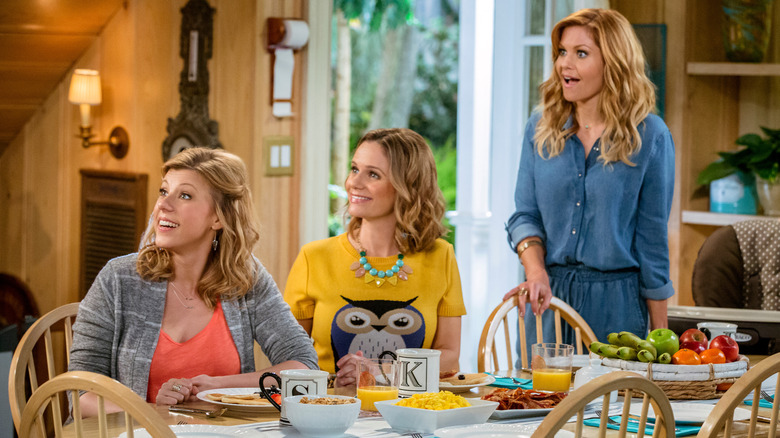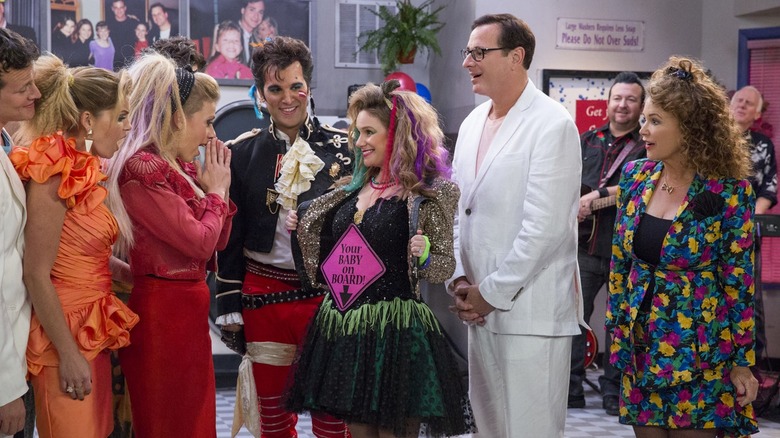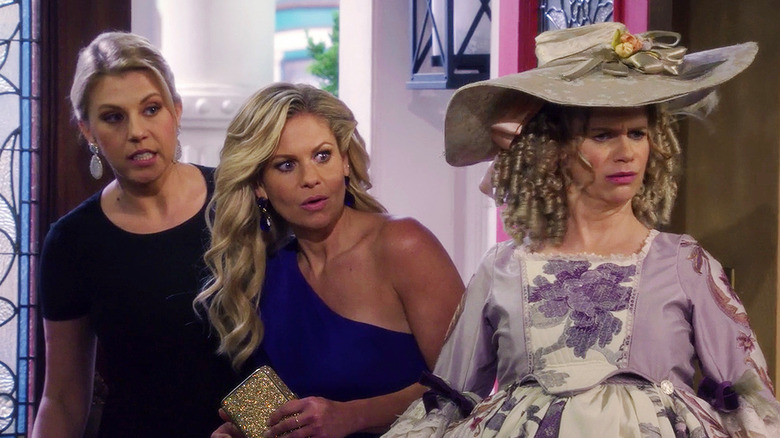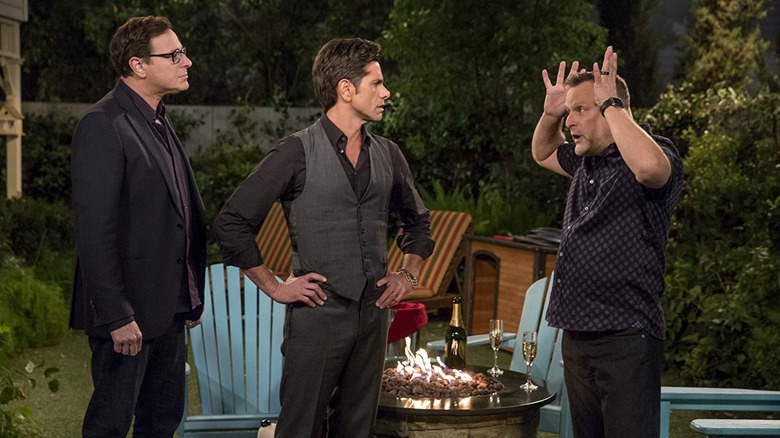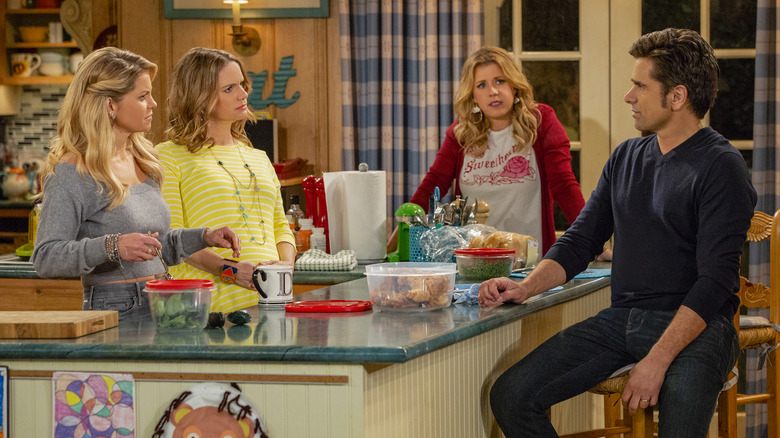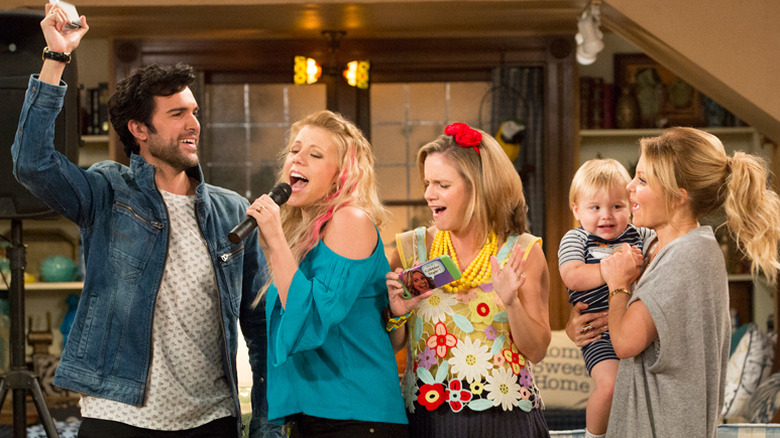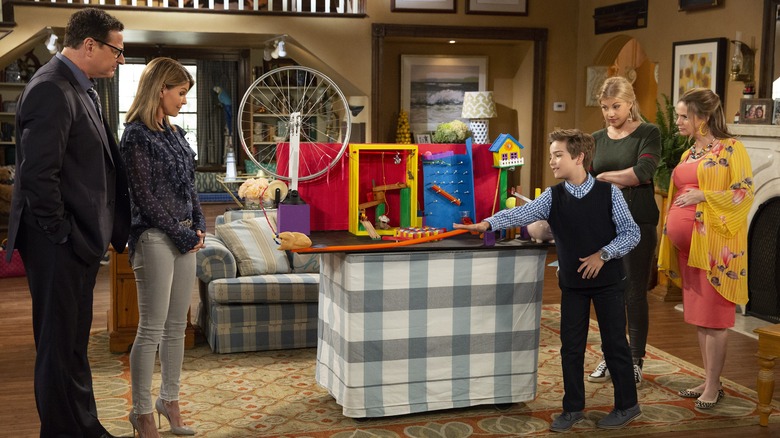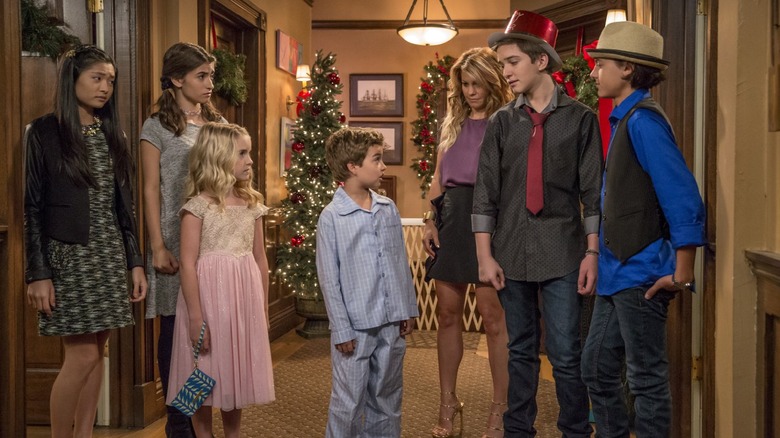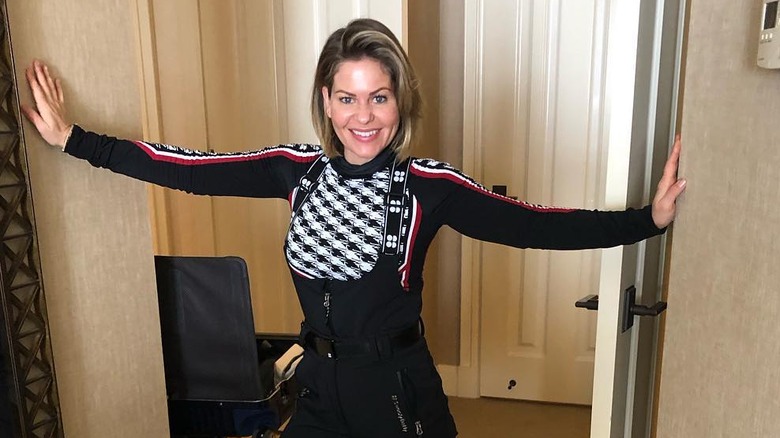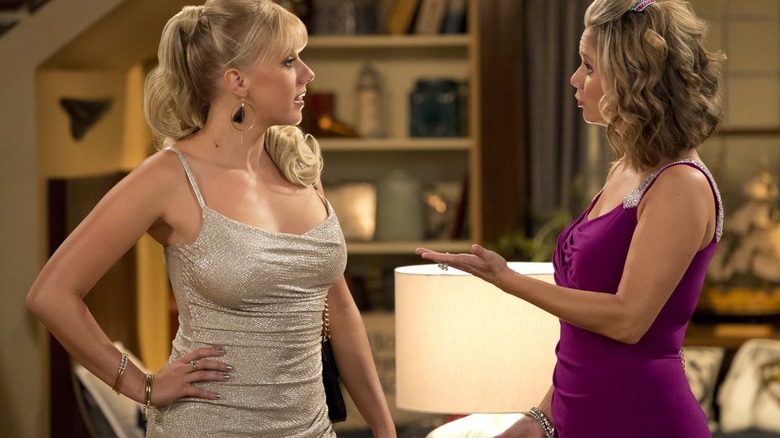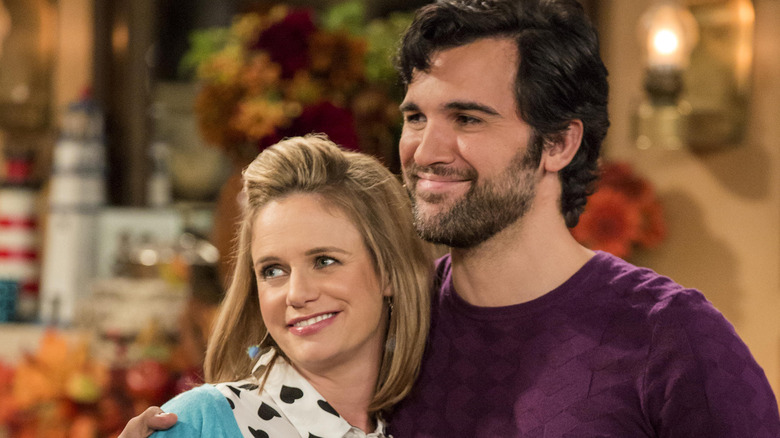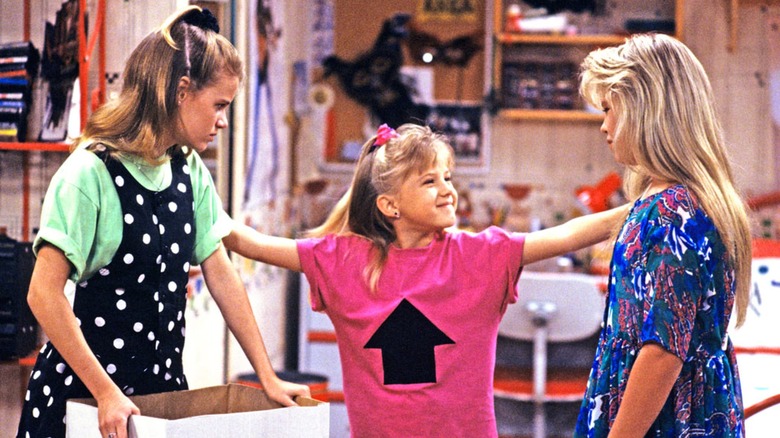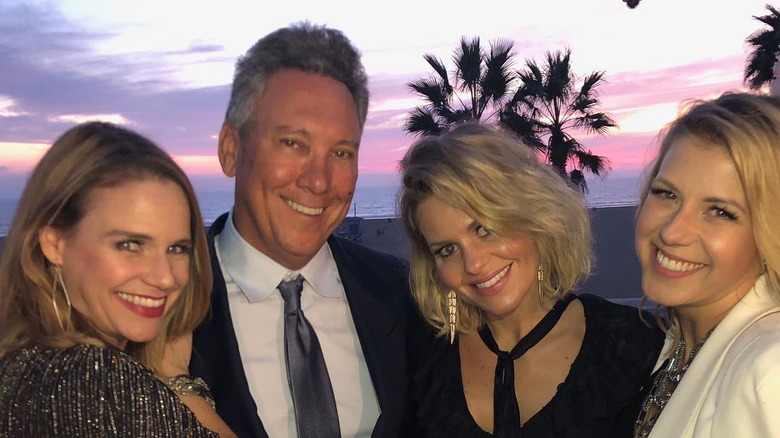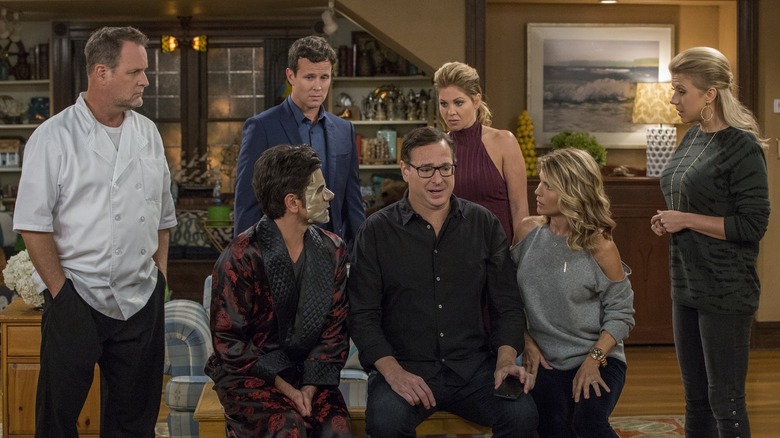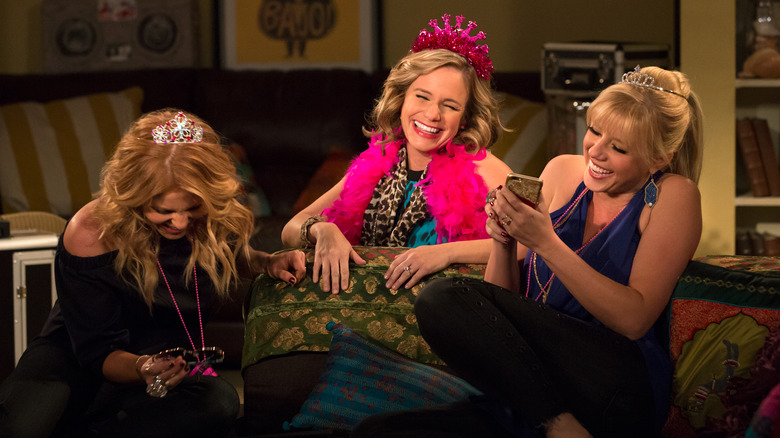The Real Reason Fuller House Is Being Cancelled
In 1987, American audiences were introduced to the Tanners, a San Francisco family comprised of three young girls, their father, his brother-in-law, and his best friend. Full House premiered on ABC in 1987, and over the course of its eight seasons, it consistently made the Top 30 in Nielsen ratings. It's done even better in syndication. According to Vulture, reruns on Nick at Nite "draw more female viewers ages 18 to 34 than new broadcast and cable shows airing at the same time."
When Netflix's revival series Fuller House premiered in 2016, it became one of the streaming service's biggest hits. According to data from Symphony Advanced Media via IndieWire, episodes averaged 14.4 million viewers, making Fuller House the number one TV show for the entire year. But Fuller House's popularity was short-lived. After only five seasons, its final episodes will be released in 2019. While many hadn't seen its cancellation coming, the signs pointing to it have been there all along.
Competition from other streaming series
Netflix has a huge catalog of content for subscribers to stream. According to the Netflix search engine Flixable, the streaming service's TV catalogue at the end of 2018 included over 1500 titles. In 2010, Netflix only had 530 to choose from, meaning that in less than a decade, television options on the platform have nearly tripled.
In an article published by Recode, viewership data from the analytics company Jumpshot listed the most viewed shows on Netflix in 2018, and Fuller House didn't even crack the top 20. Part of the issue likely has to do with the fact that Netflix licenses much of its content from companies that have plans to launch their own streaming services, which means that shows like Friends and The Office have an expiration date on the platform. So if given the choice, fans are going to choose reruns of Gilmore Girls over new Fuller House episodes while they still have the chance.
It was never really that good to begin with
Let's be real for a minute: The appeal of a series like Fuller House has nothing to do with its merit as a quality TV show. Its success came as a result of nostalgia, and the series' first season reviews are a reflection of that sentiment. At the time of publication, Season 1 of Fuller House is certified rotten on Rotten Tomatoes, holding a 34% critics score. The consensus for the season is this: "After the initial dose of nostalgia, Fuller House has little to offer to anyone except the original series' most diehard fans."
And that's the nicest of it. Critics didn't hesitate to leave the sugarcoating by the wayside. One particularly scathing review via Daniel Fienberg at The Hollywood Reporter calls the show, "a mawkish, grating, broadly played chip off the Full House block." He argues that Full House was never a good show either, relying instead on the "basest of family-friendly instincts." In fact, of the 47 reviews that first season of Fuller House received, only 16 of them were positive. And of those, only a handful actually came from "top critics."
It wasn't actually about the Fuller family anyway
Ultimately, the draw for fans of Fuller House was getting to see the original Full House cast back together again (minus, of course, Mary-Kate and Ashley Olsen, who were noticeably absent from the revival, but were referenced time and time again because of it). The show itself isn't original in any sense. Feinberg notes in his The Hollywood Reporter review that Fuller House "is almost non-stop references to the original series, filling-in-the-gaps exposition and then a climactic homage to the Full House pilot that includes both clips from that series and reenactment." The premise is identical to its predecessor, with the exception of its gender-swap twist.
But as Paul Tassi explains in Forbes, Fuller House is less of a revival than it is an actual reunion of the original cast. "It gets to exist sort of frozen in time. No matter what happened to the actors, the characters feel immortal." Viewers could care less about D.J.'s current love triangle. They just want to see what Uncle Jesse's been up to.
Huge drop in viewership
Fuller House certainly had a strong first season, and even by Season 3, it continued to be one of Netflix's most "binge-raced" shows. According to a 2017 Netflix press release, "Binge Racers are defined as members who completed a season of a TV show within 24 hours of its release on Netflix." Fuller House came in second on its list, losing out only to Gilmore Girls: A Year in the Life. Essentially, Fuller House's strength lies in its ease of watchability. Viewers can blow through 13 episodes in no time.
But binge-ability isn't the same as viewership, and Fuller House struggled to maintain its audience in later seasons. Business Insider published viewership data collected from Jumpshot that showed an enormous 52% drop in viewers between seasons 1 and 2, meaning fans of the show likely got what they came for early on and had no desire for seconds. Between seasons 3 and 4, the number dropped again. Although it was only by 10%, the damage had already been done.
Netflix is no longer a safe haven
For years, Netflix was the place that failing or cancelled network shows came to for renewal. The reason for it likely due to the fact that Netflix works via overall viewer experience, as opposed to ratings. During the 2016 Television Critics' Association's summer press tour, Netflix's content chief Ted Sarandos explained that because Netflix gets revenue from subscriptions as opposed to advertising, ratings numbers mean little to the company.
But that was then, and this is now. According to Cinema Blend, Netflix has recently begun to cut their content sooner, which suggests that ratings may have come to mean more to the platform than they did before. In fact, Cinema Blend goes on to say that although Netflix seems to be spending more money than ever on original programming, even newer series — like Seven Seconds — have had difficulty making it beyond their first season, regardless of positive critical response. As Netflix grew, the competition on the platform thus became even more cut-throat.
Studio audience sitcoms don't work for Netflix
The last thing that Netflix should do as a commercial-free streaming service is put out the style of television that begs for a commercial break. Canned laughter coupled with the multi-cam studio audience setup of '80s and '90s comedies is a formula that just isn't meant for a platform like Netflix. Hank Stuever at The Washington Post calls the setup, "Too dopey, too boring, not worth the price," and added: "This show begs for a single-camera, Tina Fey-style treatment (like in Unbreakable Kimmy Schmidt)."
In fact, even on network TV, there's been a shift away from the multi-cam format. According to The New York Times, the single camera setup has been making a comeback. "There is also a consensus in the industry that the multi-camera sitcom has gotten stale," it says. For a show that's only been running for three years to already feel stale, it's understandable why Netflix has decided to pull the plug. Fuller House may be chock-full of nostalgia, but that's clearly not enough to sustain a show long-term.
High production costs
Production costs on a show like Fuller House may not have been as high as some of Netflix's other hit series, but for a comedy made up of a substantial number of veteran TV actors, it may also not have been worth it to continue. Then, there are also the child actors to consider. TMZ published the salaries of the kids on the show, and Sonia Bringas, who plays Kimmy's daughter Ramona, makes $15,000 an episode, while Michael Campion, who plays D.J.'s oldest son, makes $12,000. Elias Harger, who plays her middle son, makes $10,000 per episode.
CAA TV literary agent Peter Micelli spoke with Variety about just how much money Netflix shells out for its original programming, and it is not cheap. "The cheapest show is $3.8 million an episode," he said. Even if Fuller House were that show, its steady decline in viewers may have been enough for Netflix to decide its price tag was simply too high to justify keeping it around.
The wrong Tanner was the star
The cast of Fuller House are no strangers to controversy. From Bob Saget's notoriously dirty sense of humor, to Jodie Sweetin's drug-fueled past, to Lori Loughlin's 2019 bribery indictment, they've all had their fair share of bad press. But vulgarity and addiction can be easily forgiven and forgotten in Hollywood. Controversial religious stances are a little harder.
Candace Cameron Bure has always been pretty open about her faith. In 2018, the actress appeared on The Wendy Williams Show and said she's faced discrimination for her Christian views in the past, but that nowadays she's actually known for them. According to People, Bure has gone head to head publicly with several people over what she deems "freedom of association" and "constitutional rights," most notably in 2015 during an on-air clash with The View co-host Raven-Symoné regarding a same-sex wedding cake.
Bure's polarizing opinions have led her to become more well-known for her political and religious beliefs than for her acting, which is the kind of notoriety a company as mainstream as Netflix might have been better off avoiding.
Outrage from parents
Unfortunately, even Bure's conservative image couldn't shield Fuller House from angry parents who deemed the series inappropriate for children. On Common Sense Media, parents noted the show's sexual references, skimpy clothing, and use of alcohol as examples of why the show isn't actually being family friendly.
According to one parent on the site, it was difficult to determine from the first episode who the show was actually for, as he felt uncomfortable allowing his kids to sit through it. Many parents echoed this sentiment, questioning how Netflix could have given it a G-rating, given its penchant for adult content. Another parent went so far as to say, "They have caved into Hollywood's smut and inappropriateness," while others wondered how someone with Bure's religious beliefs could have anything to do with it in the first place. Nearly all of the reviews from parents agreed they would not be giving Fuller House a second chance.
It was oblivious to the world around it
Fuller House tries desperately to take everything that was wonderful about Full House and recreate it. The problem, though, is that Full House lived in the '90s, whereas Fuller House lives (or should live) in the here and now — decades past the new millennium. Vanity Fair's Richard Lawson explains the show's inability to acknowledge its time and place as such: "Fuller House reflects so little of the world that when something real and difficult does, somehow, manage to crack the show's thick plastic veneer, it's startling, almost grotesque." He goes on to explain how the show glosses over its more serious issues, like Kimmy's emotionally manipulative ex, or Jesse and Rebecca's adoption of a child of color.
What's more, Fuller House takes place in San Francisco, one of the most progressive and LGBTQ-friendly cities in the country, yet it rarely ever mentions queerness. Viewers found out that Stephanie had once had a relationship with another woman, but it's presented as a single throwaway line in Season 4 — one that Us Weekly explains was ad-libbed on the fly.
The end of nostalgia
Fuller House was one of several TV revival series that hoped to find success from the nostalgia surrounding shows that came before them — Heroes Reborn, Will & Grace, and Roseanne all came to TV around the same time. But as TV Editor Andrew Husband notes in Metro, with the exception of one or two, most of the revivals have failed. Husband goes on to say, "perhaps TV executives and the audiences they vie for are beginning to lose interest in the trend." With companies like Hulu and Amazon focusing these days on creating more original content, there's less of a need to rely on old TV successes.
One development exec spoke with Vulture and said that she will generally pass on reboots. "We're not just going to remake stuff just because it's beloved in some way," she says. It's a sentiment that other execs feel as well, especially considering how many reboots have failed before even making it past a pilot. For many companies, the focus is moving away from "tentpoles and franchises," and moving toward innovation and originality.
Abuse on set
When Fuller House came to Netflix in 2015, it brought Jeff Franklin, Full House's original showrunner, with it as executive producer. But in February 2018, Variety reported that Franklin had been fired from the show, and Warner Bros. TV had declined to renew his contract. According to the publication, Franklin had a history of being verbally abusive toward Fuller House staff. He was also known to make "sexually charged comments about his personal relationships and sex life."
But it wasn't just Franklin's comments that got him into trouble. A source for Variety says the showrunner had a habit of giving small roles on the show to women he was dating. Execs at Warner Bros. TV had apparently been notified of Franklin's behavior two years prior to his firing, but it took numerous complaints before the studio actually launched an investigation. Franklin confirmed his exit on Instagram and said that he wished the cast "continued success."
It wasn't expected to last
Fuller House did release a fourth season after Franklin's firing, albeit with five fewer episodes than its previous one. According to TVLine, Netflix had been "seriously considering" cancelling the show once it wrapped its fourth season. At the time, a spokesperson for Netflix refused to elaborate on the Fuller House's fate and said the company had yet to make a decision regarding the future of the series, which led to speculation that it wouldn't last beyond its 2018 season.
Cast members were quick to defend the show, however. Bure spoke with E! News at the time and said, "I don't know why or how that rumor got started. In the four years we've been doing Fuller House, they never announce a pickup before the season airs." But without any definitive answers from Netflix or the show's stars, fans were left to wonder about the fate of the Tanner-Fuller family and its inevitable final episodes.
It had its run
At the end of the day, Fuller House had a good run. Audiences quenched that nostalgia-driven thirst to see how the cast of Full House had turned out so many years (well, actually decades) later. They got to relive the most famous catchphrases of their youth — "How rude!" — and they saw that the Tanner-Fuller world was pretty much exactly the same as the Tanner one of past. When Netflix released the Season 5 trailer, its stars claimed they were "saving the best for last," which suggests that everyone kind of knew it was time to end.
A source close to the show spoke with E! News and said, "everyone is thrilled to come back for the fifth and final season, mainly because they were close to being cancelled altogether. For Netflix and the pacing of the show, five seasons is a perfect run." It may not have made the same impact that Full House did in its original eight seasons, but Fuller House — and its nostalgic approach to television — did what it set out to do: bring the original cast back for one final goodbye.
